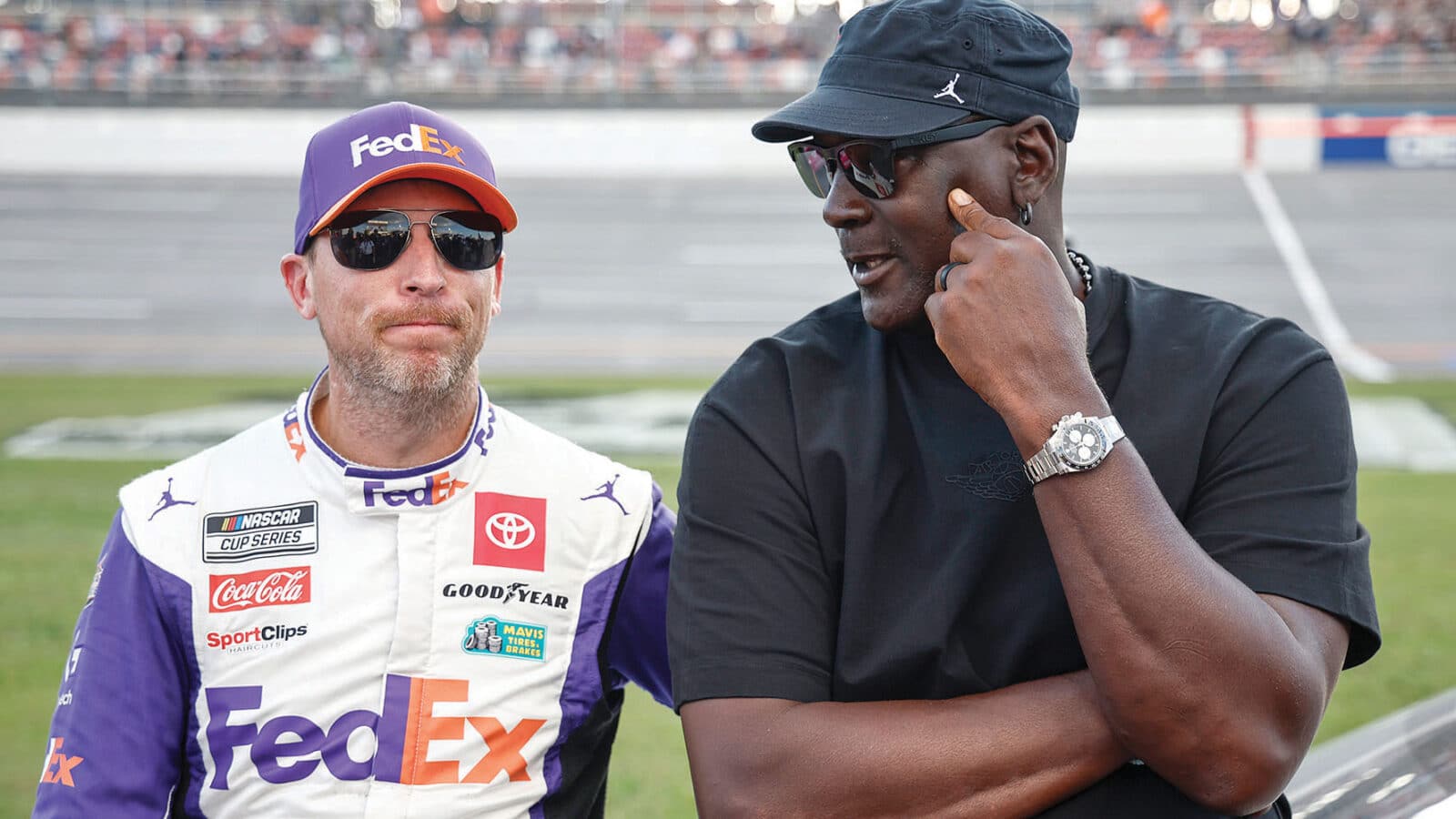Will new TV deal — and Will Buxton — put gloss on ‘stagnant’ IndyCar?
John Oreovicz on a golden era for IMSA, how Will Buxton can fire-up IndyCar and why Michael Jordan isn’t cock-a-hoop

Owners of NASCAR team 23XI Racing – Denny Hamlin and that Michael Jordan
Getty Images
US sports car racing went through its own ‘split’ starting in 1999 that thankfully created far less-lasting damage than the CART/IRL IndyCar schism. Since the American Le Mans Series and Grand-Am merged under the IMSA banner in 2014, sports car’s popularity has been on an upwards trend, accelerating since John Doonan became IMSA president in 2019.
Doonan and his team created the LMDh (Le Mans Daytona hybrid) platform that gives IMSA manufacturers and teams the ability to compete against the likes of Ferrari and Toyota and their bespoke Hypercars at the Le Mans 24 Hours and other FIA WEC events. The cost-effective LMDh formula has already attracted six manufacturers to the SportsCar Championship including Porsche, BMW, Cadillac and Honda (Acura); Genesis (Hyundai) and Ford have announced future participation. Eighteen carmakers race across IMSA’s series.
There’s plenty of talk about how this is a golden era for IMSA and sports car racing in the US, and for once the hype is true. Daytona International Speedway’s infield was packed for the season-opening Daytona 24 Hours, and the record crowd was treated to a race that was resolved with a pass for the lead in the final half hour, a margin of victory of less than 2sec, and a double podium for Porsche Penske.
The LMDh machines aren’t quite as exotic as the WEC Hypercars (which are eligible for IMSA homologation), but they are by far the most advanced cars racing in the US. Marques integrate their own engine and bodywork to an approved LMP2-based chassis and spec gearbox/hybrid package, creating racers that look and sound different despite their underlying similarities. In that regard, IMSA has perfectly executed a concept conceived by IndyCar in 2010 that instead produced the unlamented ‘aero kit’ cars that raced 2015-17.
“IndyCar enters 2025 using a chassis and engine that date to 2012”
IndyCar, by contrast, enters 2025 using a chassis and engine that date to 2012, freshened over the years with bodywork and safety mods and a mild spec hybrid system. In its sixth season under the ownership guise of Penske Entertainment, IndyCar continues to ignore its stagnant formula and is pinning its hopes for future growth on a new television partnership with the Fox network featuring Drive to Survive pundit Will Buxton as lead commentator.
There’s a precedent: Fox ventured into American motor sport in 2001, acquiring broadcast rights for the first half of the NASCAR schedule for a staggering £1.7bn over six years. It paid off for both Fox and NASCAR. With interest boosted by the death of Dale Earnhardt in Fox’s very first race (the 2001 Daytona 500) ratings on Fox skyrocketed and NASCAR’s popularity soared.
NASCAR’s recent television ratings are barely half of what they were at their peak in 2005-06, but an average of nearly three million viewers per race triples IndyCar’s numbers. So does the money; Fox and three other entities will pay £6.2bn for the rights to broadcast NASCAR until 2031. In comparison, IndyCar’s television revenue is pennies on the dollar.
Fox has retained driver analysts James Hinchcliffe and Townsend Bell from the prior NBC booth; former IndyCar commentator Leigh Diffey now anchors NBC’s NASCAR coverage, and while Australian Diffey’s energetic presence has polarised the ‘patriotic’ American audience, ratings have held steady.
Buxton, who made a brief cameo as a pit reporter in IndyCar a decade ago before returning to F1, immediately stated his belief that IndyCar should be the most popular form of motor sport in America – which it once was. That’s going to be a tall task, no matter who is fronting the action on television.
The rapid growth of cable and satellite television in the early 2000s allowed the groundbreaking NASCAR-Fox partnership to saturate the market with content, which helped fuel stock car racing’s emergence as a national powerhouse after decades as a regional novelty. That flood of content eventually created some burnout, but NASCAR’s core fanbase is still substantially larger (and more geographically widespread and diverse) than it was 30 years ago.
NASCAR continues to subscribe to the ‘more-is-better’ way of thinking. Its season started in early February with The Clash, an exhibition race which this year moved to the historic Bowman Gray Stadium, a renovated North Carolina stock car venue. The 36-race Cup Series kicked off two weeks later with NASCAR’s biggest race, the Daytona 500, and runs all the way through to November.
NASCAR has ridden out several storms since the turn of the century, including the tumultuous long-standing management reign of Brian France, the transition from a points-based championship to an elimination play-off format, a higher level of technology and a philosophical shift in the way cars are designed and built.
But one obstacle remains in the way of harmony: two of the 15 teams have brought anti-trust legal action against NASCAR and its charter system, which distributes television revenue and guarantees entry for 36 cars into every points-paying Cup race. Front Row Motorsports and 23XI Racing (co-owned by driver Denny Hamlin and basketball legend Michael Jordan) are accusing NASCAR of monopolistic business practices that prevent a fair competitive environment.
In December 2024, a federal judge ruled that FRM and 23XI could continue to compete as charter teams in 2025 until the suit is resolved – which could significantly alter or even lead to the abolishment of the charter system. Needless to say, every other Cup Series team is watching with great interest.
Based in Indianapolis, John Oreovicz has been covering US racing for 30 years. He is author of the 2021 book Indy Split
